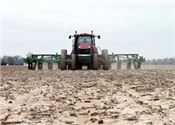|
Markets, Rain Play Havoc With Planting Decisions
STARKVILLE, MISS.
Crop decisions made in January based on markets and profit potential may be cloudy memories for growers waiting on fields to dry out enough to allow spring plantings.
Brian Williams, an agricultural economist with the Mississippi State University Extension Service, said growers have purchased seed and locked in their planting intentions, unless rains prevent timely plantings. Few changes will be based on the market’s response to the U.S. Department of Agriculture Prospective Plantings Report released March 31.
Based on the USDA report, Williams said Mississippi’s total acreage will be 74,000 more acres than last year. Mississippi growers planted 4.301 million acres last year. This year, growers are forecast to plant 4.375 million acres.
Cotton …
“In December, cotton prices were favorable compared to some of the other crops, which encouraged growers to expand their cotton intentions,” Williams said. “Today, cotton prices are not quite as good, comparatively, as they were back when decisions were being made.”
USDA forecasts 450,000 cotton acres in Mississippi, up 41 percent from 320,000 acres last year. The U.S. cotton crop is up 11 percent.
Corn …
Williams said corn was the biggest surprise in the report, and the market flinched.
“Acreage was higher than expected, both for the nation and for Mississippi,” Williams said. “Corn finished down 15 cents per bushel in just a few hours after the report was released. It was running $3.62 per bushel before the report, dropped to $3.54 per bushel and slowly trended down the next couple hours. Sometimes the market will overreact and recovery will occur in following days.”
USDA is predicting Mississippi’s corn acreage at 800,000, a 57 percent increase from last year’s 510,000 acres. Nationally, corn is up 6 percent.
Erick Larson, Extension grain crops specialist, said growers need some dry weather during April to make that acreage increase a reality. Currently, corn planting is behind schedule.
“Our typical planting window for corn is from the first of March to mid-May, depending on the field’s location in the state. If rain delays corn too much, growers may switch to another crop,” Larson said.
“MSU research shows that fields with access to irrigation can be planted through April or later, especially in our most northern counties,” he said. “We are irrigating more crops in the hill region of the state than we once did. Growers are relying on surface water and seeing a good return on their investments. With irrigation, growers planting late can maintain higher yields.”
Larson said rotation plans are an important strategy growers use to significantly enhance yield potentials and reduce risks with pests and diseases that build up from repeated plantings. Rotations also reduce costs and inputs needed to control those problems.
Sorghum …
Williams said sorghum prices in recent years were strong compared with corn, largely because of good export opportunities. That situation has changed, causing a large drop in sorghum acreage. Mississippi growers are set to plant 50,000 acres of sorghum, down 58 percent from 120,000 acres last year.
Soybean …
Mississippi soybean acreage appears to have the greatest total decline, according to the report.
“Soybean growers are predicted to plant 2 million acres, down 13 percent from 2.3 million acres in 2015,” Williams said. “Corn and soybean prices have been moving together in recent months. Corn is down about 7 percent, and soybeans are down about 6 percent from a year ago.”
Trent Irby, Extension soybean specialist, said the reduction is likely a result of market prices.
“Profit margins are tight this season, so growers need favorable conditions during April to get the crop established,” Irby said. “Mid-April is the optimum planting period in terms of setting the yield potential for soybean. Getting the crop established during this window will help growers maintain higher yields, which will be important this season, given the lower commodity prices.”
Rice …
Rice acreage is expected to be sharply higher with 17 percent more acres expected nationally. Mississippi producers plan to plant 47 percent more rice this year – an expected 220,000 acres.
Bobby Golden, Extension rice specialist based at the MSU Delta Research and Extension Center in Stoneville, said rice tends to provide reliable yields for experienced growers but can be a challenge for newer growers.
“We want rice to flower outside (before or after) the hottest days. That’s one of the reasons we push for earlier plantings, but some years, even that doesn’t work,” Golden said. “We are just entering the optimal planting window from the last week of March until the first week of May, or later for hybrid varieties. Practically no rice is planted yet, and it could be near the middle of April before fields are dry enough to plant. Once they dry out, growers will be pushing it fast.”
Peanut …
Mississippi producers are expected to plant 40,000 acres of peanuts this summer, which is 9 percent less than last year’s 44,000 acres.
Sweet potato …
Sweet potato acreage in Mississippi is expected to be down slightly at 25,000 acres, compared with 27,000 acres a year ago.
Hay …
Forage growers may harvest 700,000 acres of hay, up slightly from 680,000 acres last year. ∆

Like jets lining up on a runway, Mississippi growers are ready to take off
and resume their planting as soon as the weather allows. Shaifer Bell
of Huddleston Planting Co. is at the controls of this tractor as he plants
corn near Metcalfe, Mississippi, on March 30, 2016.
Photo by MSU Delta Research and Extension Center Communication Department
|
|